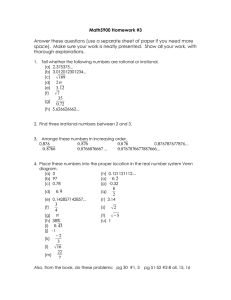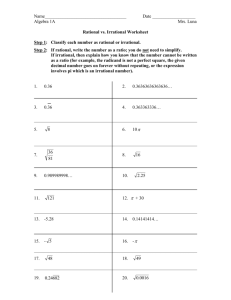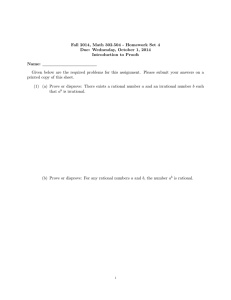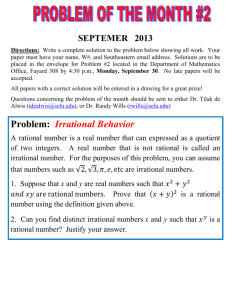114 Groups and Rings 2008–09 Suggested solutions to exercise set 7
advertisement
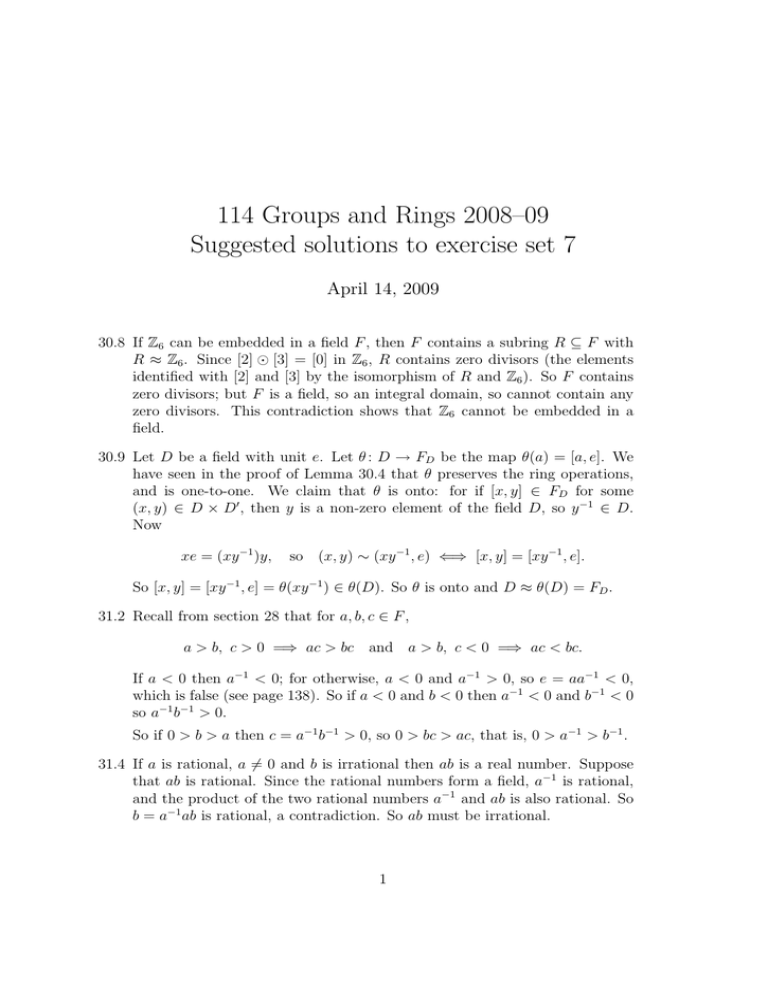
114 Groups and Rings 2008–09 Suggested solutions to exercise set 7 April 14, 2009 30.8 If Z6 can be embedded in a field F , then F contains a subring R ⊆ F with R ≈ Z6 . Since [2] [3] = [0] in Z6 , R contains zero divisors (the elements identified with [2] and [3] by the isomorphism of R and Z6 ). So F contains zero divisors; but F is a field, so an integral domain, so cannot contain any zero divisors. This contradiction shows that Z6 cannot be embedded in a field. 30.9 Let D be a field with unit e. Let θ : D → FD be the map θ(a) = [a, e]. We have seen in the proof of Lemma 30.4 that θ preserves the ring operations, and is one-to-one. We claim that θ is onto: for if [x, y] ∈ FD for some (x, y) ∈ D × D0 , then y is a non-zero element of the field D, so y −1 ∈ D. Now xe = (xy −1 )y, so (x, y) ∼ (xy −1 , e) ⇐⇒ [x, y] = [xy −1 , e]. So [x, y] = [xy −1 , e] = θ(xy −1 ) ∈ θ(D). So θ is onto and D ≈ θ(D) = FD . 31.2 Recall from section 28 that for a, b, c ∈ F , a > b, c > 0 =⇒ ac > bc and a > b, c < 0 =⇒ ac < bc. If a < 0 then a−1 < 0; for otherwise, a < 0 and a−1 > 0, so e = aa−1 < 0, which is false (see page 138). So if a < 0 and b < 0 then a−1 < 0 and b−1 < 0 so a−1 b−1 > 0. So if 0 > b > a then c = a−1 b−1 > 0, so 0 > bc > ac, that is, 0 > a−1 > b−1 . 31.4 If a is rational, a 6= 0 and b is irrational then ab is a real number. Suppose that ab is rational. Since the rational numbers form a field, a−1 is rational, and the product of the two rational numbers a−1 and ab is also rational. So b = a−1 ab is rational, a contradiction. So ab must be irrational. 1 31.8 Let x = 0.035. We have 99x = 100x − x = 3.535 − 0.035 = 3.5 = so x = 7 . 2×99 7 2 So 1.935 = 1.9 + 0.035 = 19 7 1916 + = . 10 2 × 99 990 31.23 This is true (provided a 6= 0). If a is irrational and a−1 is rational, then aa−1 = 1 is irrational by exercise 31.4, which is false since 1 ∈ Q. So a−1 must be irrational. [If a = 0 then the question is moot since a−1 is not defined.] √ √ √ √ √ √ 31.25 2 and 3 are both irrational, as is 6 = 2 3. On the other hand, 2 and √12 are both irrational, but their product is 1, which is rational. 32.6 Recall Fermat’s Little Theorem: if p is prime then for any x ∈ Zp we have xp = x in Zp , so xp − x + [1] = [1] 6= [0]. So the polynomial equation xp − x + [1] = [0] has no solution in Zp and has degree p − 1 > 1. So Zp is not algebraically closed. 32.17 Let θ : C → C be an isomorphism with θ(a) = a for each a ∈ R. Since θ(−1) = −1, we have θ(i)2 = θ(i2 ) = θ(−1) = −1. Let θ(i) = x + yi where x, y ∈ R. We have (x + yi)2 = −1 ⇐⇒ x2 − y 2 + 2xyi = −1 ⇐⇒ x2 − y 2 = −1 and 2xy = 0, so xy = 0, so x = 0 or y = 0. If y = 0 then x2 = −1, which has no real solutions (as x2 > 0 for all x ∈ R with x 6= 0 by Lemma 28.1). So we must have x = 0 and −y 2 = −1 ⇐⇒ y 2 = 1 ⇐⇒ y = ±1. So either θ(i) = i or θ(i) = −i. For any a, b ∈ R we have θ(a + bi) = θ(a) + θ(bi) = a + θ(b)θ(i) = a + bθ(i). So if θ(i) = i then θ(a + bi) = a + bi for all a, b ∈ R; and if θ(i) = −i then θ(a + bi) = a + b(−i) = a − bi for all a, b ∈ R. 2

